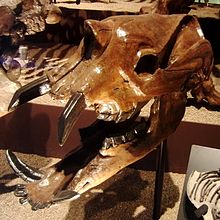South American native ungulates
| Meridiungulata | |
|---|---|

| |
| Toxodon platensis | |
| Scientific classification | |
| Kingdom: | |
| Phylum: | |
| Class: | |
| Infraclass: | |
| Superorder: | Laurasiatheria? (most probably)
|
| (unranked): | †Meridiungulata |
| Orders | |
| |
Meridiungulata is an extinct clade with the rank of cohort or superorder, containing the South American ungulates Pyrotheria (possibly including Xenungulata), Astrapotheria, Notoungulata and Litopterna. It is not known if it is a natural group; it was erected to distinguish the ungulates of South America from other ungulates. Relationships between the orders inside Meridiungulata remain unresolved and it could well be a 'wastebasket' taxon. Most Merdiungulata died out following the invasion of South America by North American ungulates and predators during the Great American Interchange; a few of the largest species of notoungulates and litopterns survived until the end-Pleistocene extinctions.
Taxonomy
Meridiungulata may have originated in South America from a North American condylarth ancestor,[1] and they may be members of the clade Laurasiatheria, related to other ungulates, including artiodactyls and perissodactyls.[2] It has, however, been suggested the Meridiungulata are part of a different macro-group of placental mammals called Atlantogenata.[3]
Much of the evolution of meridiungulates occurred in isolation from other ungulates, a great example of convergent evolution. However, the argument that meridiungulates are related to artiodactyls and perissodactyls needs support from molecular sequencing. Some paleontologists have also challenged the monophyly of Meridiungulata by suggesting that the pyrotheres may be more closely related to other mammals, such as Embrithopoda (an African order that may be related to elephants), than to other South American ungulates.[4]
Results from the sequencing of collagen from Pleistocene fossils of the notoungulate Toxodon and the litoptern Macrauchenia have indicated that at least these two orders are indeed laurasiatheres, and more specifically, form a sister group to odd-toed ungulates.[5]
Classification

The following classification is from Rose 2006:
- †Meridiungulata
- Didolodus (incertae sedis)
- Amilnedwardsia (Notopterna?)
- Order †Notoungulata
- Suborder †Notioprogonia
- Suborder †Toxodontia
- Suborder Typotheria
- Suborder Hegetotheria (Typotheria?)
- Order †Litopterna (Panameriungulata)
- Order †Astrapotheria
- Order †Pyrotheria
- Order †Xenungulata
Notes
- ^ Muizon & Cifelli 2000
- ^ Hunter & Janis 2006
- ^
Darren Naish (2008-02-08). "Snorki the giant's friends and relatives". Tetrapod Zoology. Archived from the original on 21 May 2013. Retrieved 2014-10-07.
{{cite web}}: Unknown parameter|deadurl=ignored (|url-status=suggested) (help) - ^ Shockey & Anaya 2004
- ^ Welker et al. 2015
References
- Hunter, J.P.; Janis, C.M. (2006). "Spiny Norman in the Garden of Eden? Dispersal and early biogeography of Placentalia". Journal of Mammalian Evolution. 13 (2): 89–123. doi:10.1007/s10914-006-9006-6. OCLC 4669969299.
{{cite journal}}: Invalid|ref=harv(help) - McKenna, M.C. (1975). "Toward a phylogenetic classification of the Mammalia". In Luckett, W.P.; Szalay, F.S. (eds.). Phylogeny of the primates: a multidisciplinary approach (Proceedings of WennerGren Symposium no. 61, Burg Wartenstein, Austria, July 6–14, 1974. New York: Plenum. pp. 21–46. doi:10.1007/978-1-4684-2166-8_2. ISBN 978-1-4684-2168-2.
{{cite book}}: Invalid|ref=harv(help) - Muizon, C. de; Cifelli, R.L. (2000). "The "condylarths" (archaic Ungulata, Mammalia) from the early Paleocene of Tiupampa (Bolivia): implications on the origin of the South American ungulates". Geodiversitas. 22 (1): 47–150. Retrieved May 2013.
{{cite journal}}: Check date values in:|accessdate=(help); Invalid|ref=harv(help) - Rose, Kenneth David (2006). The beginning of the age of mammals. Baltimore: JHU Press. ISBN 0801884721.
{{cite book}}: Invalid|ref=harv(help) - Shockey, B.J.; Anaya, F. (2004). "Pyrotherium macfaddeni, sp. nov. (late Oligocene, Bolivia) and the pedal morphology of pyrotheres". Journal of Vertebrate Paleontology. 24 (2): 481–488. doi:10.1671/2521.
{{cite journal}}: Invalid|ref=harv(help) - Welker, F.; Collins, M. J.; Thomas, J. A.; Wadsley, M.; Brace, S.; Cappellini, E.; Turvey, S. T.; Reguero, M.; Gelfo, J. N.; Kramarz, A.; Burger, J.; Thomas-Oates, J.; Ashford, D. A.; Ashton, P. D.; Rowsell, K.; Porter, D. M.; Kessler, B.; Fischer, R.; Baessmann, C.; Kaspar, S.; Olsen, J. V.; Kiley, P.; Elliott, J. A.; Kelstrup, C. D.; Mullin, V.; Hofreiter, M.; Willerslev, E.; Hublin, J.-J.; Orlando, L.; Barnes, I.; MacPhee, R. D. E. (2015-03-18). "Ancient proteins resolve the evolutionary history of Darwin's South American ungulates". Nature. doi:10.1038/nature14249. ISSN 0028-0836.
{{cite journal}}: Invalid|ref=harv(help)
